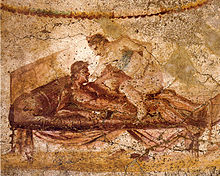
Back الدعارة في روما القديمة Arabic Prostitució a l'antiga Roma Catalan Prostitución en la Antigua Roma Spanish تنفروشی در روم باستان Persian זנות ברומא העתיקה HE Prostitucija u starom Rimu Croatian Մարմնավաճառությունը Հին Հռոմում Armenian Prostituzione nell'antica Roma Italian Prostitutie in het oude Rome Dutch Prostituição na Roma Antiga Portuguese

Prostitution in ancient Rome was legal and licensed. Men of any social status were free to engage prostitutes of either sex without incurring moral disapproval,[1] as long as they demonstrated self-control and moderation in the frequency and enjoyment of sex.[2] Brothels were part of the culture of ancient Rome, as popular places of entertainment for Roman men.[2]
Most prostitutes were female slaves or freedwomen. The balance of voluntary to forced prostitution can only be guessed at. Privately held slaves were considered property under Roman law, so it was legal for an owner to employ them as prostitutes. Pimping and prostitution were, however, considered disgraceful and dishonourable activities, and their practitioners were considered “infamous” (infames); for citizens, this meant loss of reputation and many of the rights and privileges attached to citizenship. Slave-owning patrons and investors may have sought to avoid loss of privilege by appointing slaves or freedmen to manage their clandestine investments.[3] Some large brothels in the 4th century, when Rome was becoming officially Christianized, seem to have been counted as tourist attractions and were possibly state-owned.[4]
Latin literature makes frequent reference to prostitutes. Historians such as Livy and Tacitus mention prostitutes who had acquired some degree of respectability through patriotic, law-abiding, or euergetic behavior. The high-class "call girl" (meretrix) is a stock character in Plautus's comedies, which were influenced by Greek models. The poems of Catullus, Horace, Ovid, Martial, and Juvenal, as well the Satyricon of Petronius, offer fictional or satiric glimpses of prostitutes. Real-world practices are documented by provisions of Roman law that regulate prostitution, and by inscriptions, especially graffiti from Pompeii. Erotic art in Pompeii and Herculaneum from sites presumed to be brothels has also contributed to scholarly views on prostitution.[2]
- ^ Dillon & Garland 2005, p. 382.
- ^ a b c Strong 2016, pp. 142–170.
- ^ Edwards 1997, pp. 66–67, 81–82.
- ^ McGinn 2004, pp. 167–168.
© MMXXIII Rich X Search. We shall prevail. All rights reserved. Rich X Search